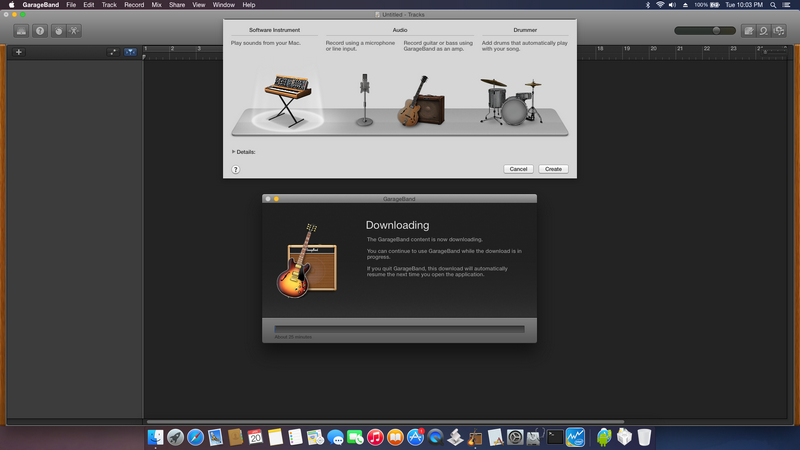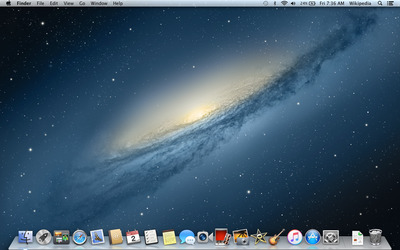With the help of professional Aiseesoft Audio Converter for Mac (Mountain Lion, Lion, Snow Leopard, Leopard), it is so easy to convert FLAC, CAF, APE, OGG, WMA, M4A, RA, AMR, QCP, SHN, BIK, MP3, WAV, AIFF, Apple Lossless ALAC, AAC to GarageBand supported audio in AIFF, WAV, AAC, Apple Lossless or MP3 with a sample rate of 44.1 kilohertz (kHz. Apr 11, 2021 These are the last versions of iLife applications to run on OS X Mountain Lion as their latest OS. Includes GarageBand 6.0.5, iMovie 9.0.9, and iPhoto 9.4.3.
How to Add Any Format of Audio Files to GarageBand ’11 or GarageBand for iOS
Overview
According to Apple Support, users can import audio files in non-protected AIFF, WAV, AAC, Apple Lossless and MP3 into a GarageBand project. Any other files in different formats such as FLAC, CAF, APE, OGG, WMA, M4A, RA, AMR, QCP, SHN, BIK will not be able to be imported to GarageBand. Even the AIFF, WAV, AAC, Apple Lossless and MP3 should have a sample rate of 44.1 kilohertz (kHz) and a bit depth of 16 bits (files with a different sample rate might play back faster or slower).
If you files cannot meet the requested specifications, you will encounter several situations:
- Record .caf files on iPhone (via Quickvoice app) and import them direct into Garageband (by dragging). Suddenly the .caf files are not working, opening (in any program). Converting them into MP3 with Switch, Handbrake, but they’re not recognised. Tellingly, the icon on the files has gone from being the ‘music notes’ icon (iTunes) to a quicktime icon.
- Recorded a very small piece of sound and try to edit it in GarageBand. GarageBand won’t allow me to add .Mp3. It says “xxxx.mp3” could not be handled because GarageBand cannot open files in the “MP3 audio” format”.
- I use my MacBook Pro mostly for making music, and today i tried to import an MP3 to Garageband and the regular dialogue of “Importing File” appeared as always, but then… NOTHING! The file isn’t there! Then i tried importing the file directly from iTunes and i couldn’t
To import audio to GarageBand ’11 or GarageBand for iOS, it is better to convert to AIFF, WAV, AAC, Apple Lossless or MP3 with a sample rate of 44.1 kilohertz (kHz) and a bit depth of 16 bits using QuickTime Pro or third party applications before importing them into GarageBand.
This article will guide you step-by-step to convert FLAC, CAF, APE, OGG, WMA, M4A, RA, AMR, QCP, SHN, BIK, MP3, WAV, AIFF, Apple Lossless ALAC, AAC to GarageBand supported audio in AIFF, WAV, AAC, Apple Lossless or MP3 with a sample rate of 44.1 kilohertz (kHz) and a bit depth of 16 bits with professional Aiseesoft Audio Converter.
Step-by-Step Guide to Convert and Import All kinds of Audio to GarageBand
PrePare: Free download Aiseesoft Audio Converter for Mac
Install and launch the the program.
Step 1: Add audio files to Aiseesoft Audio Converter

Drag and drop the audio files that you want to import to GarageBand. Or click on “Add Video” button to browse your audio files and click OK to add your files.
Step 2: Choose output audio format
Click on “Profile” drop-down and choose desired audio formats from “General Audio” category. Take converting GarageBand FLAC to MP3 for example, choose “MP3 – MPEG Layer-3 Audio (*.mp3)” from “General Audio” category.
To reserve much audio quality, you can convert your audio files to lossless AIFF or Apple Lossless. From “General Audio” category , choose “AIFF – Audio Interchange File Format (*.aiff)” as the output format.
Step 3: Customize audio parameters
- Click on “Settings” right beside of the “Profile” to open the “Profile Setting” windows.
- In the “Audio Settings”, click on the “Sample Rate” drop-down and choose 44100 Hz.
- In the “Audio Settings”, click on the “Audio Bitrate” drop-down and choose 160 kbps.
- Click “OK” to save the settings.
Step 4: Start conversion
Now, everything is set. Press on the “Convert” button to start conversion.
Step 5: Import the converted audio to GarageBand
Click “Open Folder” when the conversion is finished. Then drag and drop the converted files to GarageBand.
Conclusion
With the help of professional Aiseesoft Audio Converter for Mac (Mountain Lion, Lion, Snow Leopard, Leopard), it is so easy to convert FLAC, CAF, APE, OGG, WMA, M4A, RA, AMR, QCP, SHN, BIK, MP3, WAV, AIFF, Apple Lossless ALAC, AAC to GarageBand supported audio in AIFF, WAV, AAC, Apple Lossless or MP3 with a sample rate of 44.1 kilohertz (kHz) and a bit depth of 16 bits. Now it is such a easy thing to import desired music, songs to GarageBand for edit.
The professional Audio Converter for Mac can also help you to extract audio from video AVI, MP4, MKV, MOV, WMV, MTS, WebM, YouTube FLV, etc and convert them to GarageBand supported audio in AIFF, WAV, AAC, Apple Lossless or MP3 with a sample rate of 44.1 kilohertz (kHz) and a bit depth of 16 bits. So it is also such a easy thing to import video music to GarageBand for edit.
Related Articles
You can create sampler instruments in GarageBand by dragging sample files to the keys of the Musical Typing keyboard but it's a laborious process. Logic Pro's EXS24 Sample Instrument Editor has a load more features that make creating sampler instruments quick and easy, and allows for the editing of an wide range of parameters, none of which is possible in GarageBand.
With a little bit of tweakery, it is possible to use the sampler instruments created in Logic Pro in GarageBand '11, if you wish to extend the palette of instruments but carry on using GarageBand's more straightforward sequencing environment. Here's how:
Step 1
First create a sampler instrument in Logic Pro's EXS24 Sample Instrument Editor.
Create the sampler instrument in EXS24's Sample Instrument Editor.
Step 2

In the EXS24 Instrument Editor go to the Instrument Menu and choose 'Export Sampler Instrument and Sample Files'. You can name the instrument at this point if you haven't already done so. You can save the resultant files to any location for now.
Choose 'Export Sampler Instrument and Sample Files'.
Add the Instrument file to the following location:
Macintosh HD > Library > Application Support > GarageBand > Instrument Library > Sampler > Sampler Instruments
Add the folder of instrument samples to the following location:

Macintosh HD > Library > Application Support > GarageBand > Instrument Library > Sampler > Sampler Files
Step 3
Next we need to get GarageBand to recognize these files. You can see how GarageBand categorizes instruments if you double-click a software instrument track or click the 'i' button at the bottom right of the GarageBand window to open the Instrument Browser, then click the '˜Edit' tab.
At the top is the '˜Sound Generator' for the current instrument.
In the upper of the two Sound Generator pop-up menus make a careful note of the name of an appropriate instrument type, for example - '˜Strings'
Click on the lower of the two pop-up menus and you will see the instruments that are in this category but you won't see your instrumented listed (yet!)
The pop-up menus display the instruments that are in this category.
Step 4
In the Finder, browse to the following location:
Macintosh HD > Library > Application Support > GarageBand > Instrument Library > Plug-In Settings
In that location go inside any folder, select any .pst file inside that folder and copy it to the clipboard
Navigate to User Home > Library > Application Support > GarageBand > Instrument Library > Plug-In Settings (if you are using Lion, Mountain Lion or Mavericks you will need to hold down the Option key to be able to select the User Home > Library from the Finder's Go menu)
In that location create a folder with the exact name of the category you noted above (in the upper of the two Sound Generator pop-up menus'in our example '˜Strings') and paste the .pst file into that folder, then rename the .pst file to the name you want your instrument to have (how it will appear in the lower of the two Sound Generator pop-up menus)
Step 5
Open the .pst file with a text editor such as TextEdit or Text Wrangler. Change the part of the code that was the original name of the .pst file (which ends in .exs in the code) to the name of your EXS instrument'it is important that this matches exactly!
The .pst file renamed and opened in TextEdit with the relevant part of the text highlighted.
The .pst file edited with the same name as the EXS24 instrument created in Logic Pro.
Garageband For Mountain Lion Free
Save the text file. If GarageBand is open, close it and re-open it, then navigate to your instrument using the Sound Generator pop-up menus. GarageBand will now play your EXS instrument!
Your instrument, now available in GarageBand!
Final Notes
You can save this track instrument (together with any other track settings such as effects) so that it appears in the instrument browser and can be used in other GarageBand projects by clicking the 'Save Instrument' button at the bottom of the Instrument Browser
NOTE: custom track instruments are saved in the following location: User > Library > Application Support > GarageBand > Instrument Library > Track Settings > Software |